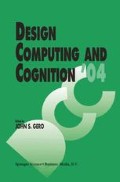Abstract
Design concepts in architecture typically feature in post-hoc explanations or reviews of finished design projects. By contrast, this paper tries to chase concepts during the design process, and shed more light on when, why and how they pop up in the designer’s mind. To this end, the role of concepts is studied through the eyes of an architect involved in the design of a school building. The results of this pilot study amount to a tentative model of the generation and development of concepts, which tries to take into account their highly elusive character.
Access this chapter
Tax calculation will be finalised at checkout
Purchases are for personal use only
Preview
Unable to display preview. Download preview PDF.
References
Akin, Ö: 1979, Models of Architectural Knowledge: An Information Processing View of Architectural Design, PhD. Dissertation, Carnegie-Mellon University, Pittsburgh, PA.
Alexander, C: 1979, The Timeless Way of Building, Oxford University Press, New York.
Bourdieu, P: 1977, Outline of a Theory of Practice, Cambridge University Press, Cambridge.
Carrara, G and Kalay, YE (eds): 1994, Knowledge-Based Computer-Aided Architectural Design, Elsevier, Amsterdam.
Chandrasekaran, B: 1999, Multimodal perceptual representations and problem solving, in JS Gero and B Tversky (eds), Visual and Spatial Reasoning in Design, Key Centre of Design Computing and Cognition, University of Sydney, pp. 3–14.
Churchland, PS and Sejnowski, T J: 1992, The Computational Brain, MIT Press, Cambridge, MA.
Cross, N: 1982, Designerly ways of knowing, Design Studies 3(4): 221–227.
Cross, N: 2000, Engineering Design Methods. Strategies for Product Design, John Wiley & Sons, Chichester.
Cross N, Christiaans H and Dorst K: 1996, Introduction: The Delft protocols workshop, in N Cross, H Christiaans and K Dorst (eds), Analysing Design Activity, John Wiley & Sons, Chichester, pp. 1–16.
Damasio, AR: 2000, The Feeling of What Happens: Body, Emotion and the Making of Consciousness, Vintage, London.
Darke, J: 1978, The primary generator and the design process, in WE Rogers and WH Ittelson (eds), New Directions in Environmental Design Research, EDRA, Washington D.C., pp.325–337.
Ericsson, KA and Simon, HA: 1984, Protocol Analysis: Verbal Reposts as Data, MIT Press, Cambridge, MA.
Goldschmidt, G: 1996, The designer as a team of one, in N Cross, H Christiaans and K Dorst (eds), Analysing Design Activity, John Wiley & Sons, Chichester, pp. 65–91.
Goldschmidt, G: 1999, The backtalk of self-generated sketches, in JS Gero and B Tversky (eds), Visual and Spatial Reasoning in Design, Key Centre of Design Computing and Cognition, University of Sydney, pp.163–184.
Hamel, RG: 1990, On Designing by Architects: A Cognitive Psychological Description of the Architectural Design Process, PhD. Dissertation, Universiteit van Amsterdam, AHA books, ’s Gravenhage.
Heylighen, A and Neuckermans, H: 2001, Destination: Practice. Towards a maintenance contract for the architect’s degree, in W Jabi (ed), Reinventing the Discourse, ACADIA, Buffalo, NY, pp. 90–99.
Holland, JH, Holyoak, KJ, Nisbett RE and Thagard, PR: 1986, Induction: Processes of Inference, Learning, and Discovery, MIT Press, Cambridge, MA.
Kosslyn SM: 1999, Visual mental images as re-presentations of the world: a cognitive neuroscience approach, in JS Gero and B Tversky (eds), Visual and Spatial Reasoning in Design, Key Centre of Design Computing and Cognition, University of Sydney, pp. 83–92.
Lawson, B: 1990, How Designers Think, Butterworth Architecture, London.
Lawson, B: 1994, Design in Mind, Butterworth Architecture, London.
Leclercq, P and Heylighen, A: 2002, 5,8 analogies per hour, in JS Gero (ed), Artificial Intelligence in Design ’02, Kluwer Academic, Dordrecht, pp. 285–303.
Lemaire, P: 1999, Psychologie Cognitive, De Boeck Université, Paris.
Leupen, B, Grafe, C, Körnig, N, Lampe, M and De Zeeuw, P: 1997, Design and Analysis, Van Nostrand Reinhold, New York , NY.
Lindekens, J, Heylighen, A and Neuckermans, H: 2003, Understanding architectural redesign, in G Aouad and L Ruddock (eds), Proceedings of the 3rd International Postgraduate Research Conference in the Built and Human Environment, University of Salford, Salford, pp. 671–681.
McClelland, JL and Rumelhart, DE: 1985, Distributed memory and the representation of general and specific information, Journal of Experimental Psychology: General 114 159–188.
McClelland, JL and Rumelhart, DE: 1988, Explorations in Parallel Distributed Processing, MIT Press, Cambridge, MA, pp.11–47.
Rowe, PG: 1987, Design Thinking, The MIT Press, Cambridge, MA.
Sharp, D: 1990, Twentieth Century Architecture: A Visual History, Facts on File, New York, NY.
Stiers, J and van Beuningen, A: 2002, Designing with DYNAMO, unpublished case study report.
Suwa M, and Tversky, B: 1997, What do architects and students perceive in their design sketches? A protocol analysis, Design Studies 18(4): 385–403.
Taura, T, Yoshimi, T, and Ikai, T: 2002: Study of gazing points in design situation. A proposal and practice of an analytical method based on the explanation of design activities, Design Studies 23(2): 165–185.
Tovey M, Porter S, and Newman R: 2003, Sketching, concept development and automotive design, Design Studies 24(2): 135–153.
Author information
Authors and Affiliations
Editor information
Editors and Affiliations
Rights and permissions
Copyright information
© 2004 Springer Science+Business Media Dordrecht
About this paper
Cite this paper
Heylighen, A., Martin, G. (2004). That Elusive Concept of Concept in Architecture. In: Gero, J.S. (eds) Design Computing and Cognition ’04. Springer, Dordrecht. https://doi.org/10.1007/978-1-4020-2393-4_4
Download citation
DOI: https://doi.org/10.1007/978-1-4020-2393-4_4
Publisher Name: Springer, Dordrecht
Print ISBN: 978-90-481-6650-3
Online ISBN: 978-1-4020-2393-4
eBook Packages: Springer Book Archive

